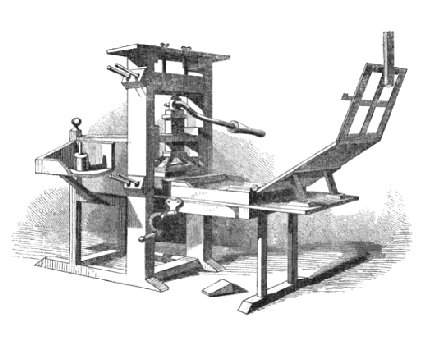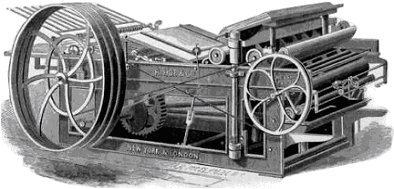

|
<<< Continued from previous page 1500-1800 This is the so-called hand-press period - and again, these are to some extent arbitrary dates. Johannes Gutenberg completed construction of his first hand press in 1440, and widespread use of hand presses continued well into the 1800s. A bigger window than ours, and many hand presses are still in use. What the hand press period does represent, however, is the approximate end of experimentation with hand presses and their associated printing techniques and a stabilization of same, somewhere around the turn of the 15th century, that was to embrace an extraordinarily extensive period of time in which very little changed in the book production process. A typical 16th century hand press:

The hand-press period is an important one for booksellers. Even if you aren't actively looking for hand-press era books, the likelihood of encountering them incidentally on the scouting trail is pretty high, especially examples produced in latter half of the 18th century. Your ability to work with them without having to wholesale them to more knowledgeable booksellers will repay itself again and again. 1800-1950 The machine-press period, as you might guess, marks the introduction of technology that accelerated book production. Steam powered presses were the first to appear, followed by binding and composing machinery. This period also heralds the introduction of machine made paper - a mnemonic convenience for us because pretty much everything leaps forward at the same time. In 1800 all paper was still being produced as it always had been - hand made, sheet by sheet, from rags - but by the 1820s machine-made paper (produced in continuous rolls) drew even, then surged ahead in the ensuing decades, more so when wood pulp paper became available about mid-century. A typical 19th century machine press:

1950 to present Technological changes aside, until the mid-20th century, most books were still being made essentially as they had been since the 15th century, that is, via inking the face of metal type, pressing paper onto it, assembling the printed paper into gatherings and sewing them into blocks to which bindings were applied. It was an amazingly consistent 500-year run. Today, of course, the great majority of books are produced by different processes. More about these later. So - think of the above fleshed out chronology as a framework upon which to build additional knowledge. If it's brand new to you, refer back to it until you've got it down cold. If not, it never hurts to dust one's skeletons. Next, there are several aspects of book history that need to be addressed in some depth before we move on - paper and printing. A working, bookselling understanding of both is critical. EDITOR'S NOTE: The complete chapter can be purchased either as a single issue of the New Gold Edition or by purchasing a subscription to the complete book (approximately 20 chapters with a projected completion date of Fall, 2011). Click here to purchase.
Want to read more articles by
< to previous article
Questions or comments?
| Forum
| Store
| Publications
| BookLinks
| BookSearch
| BookTopics
| Archives
| Advertise
| AboutUs
| ContactUs
| Search Site
| Site Map
| Google Site Map
Store - Specials
| BookHunt
| BookShelf
| Gold Edition & BookThink's Quarterly Market Report
| DomainsForSale
| BookThinker newsletter - free
Copyright 2003-2011 by BookThink LLC
|

|
|